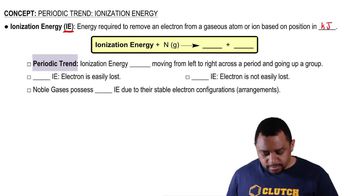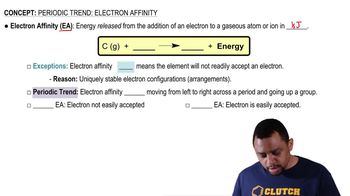Here are the essential concepts you must grasp in order to answer the question correctly.
Ionization Energy
Ionization energy is the energy required to remove an electron from an atom or ion in its gaseous state. For a potassium (K) atom, this process involves overcoming the attractive force between the negatively charged electron and the positively charged nucleus. The equation for this process can be represented as K(g) → K⁺(g) + e⁻, indicating that an electron is lost, resulting in a positively charged ion.
Recommended video:
Periodic Trend: Ionization Energy (Simplified) Concept 1
Electron Affinity
Electron affinity refers to the energy change that occurs when an electron is added to a neutral atom in the gaseous state. For a potassium ion (K⁺), gaining an electron results in the formation of a neutral potassium atom. This process can be expressed as K⁺(g) + e⁻ → K(g), where energy is typically released, indicating that the ion is more stable after gaining the electron.
Recommended video:
Periodic Trend: Electron Affinity (Simplified) Concept 1
Charge Conservation
Charge conservation is a fundamental principle in chemistry and physics stating that the total electric charge in an isolated system remains constant. In the context of the given question, when a K atom loses an electron, it becomes positively charged (K⁺), while the electron itself carries a negative charge. Similarly, when a K⁺ ion gains an electron, it returns to a neutral state, illustrating the conservation of charge throughout these processes.
Recommended video:
Law of Conservation of Mass




